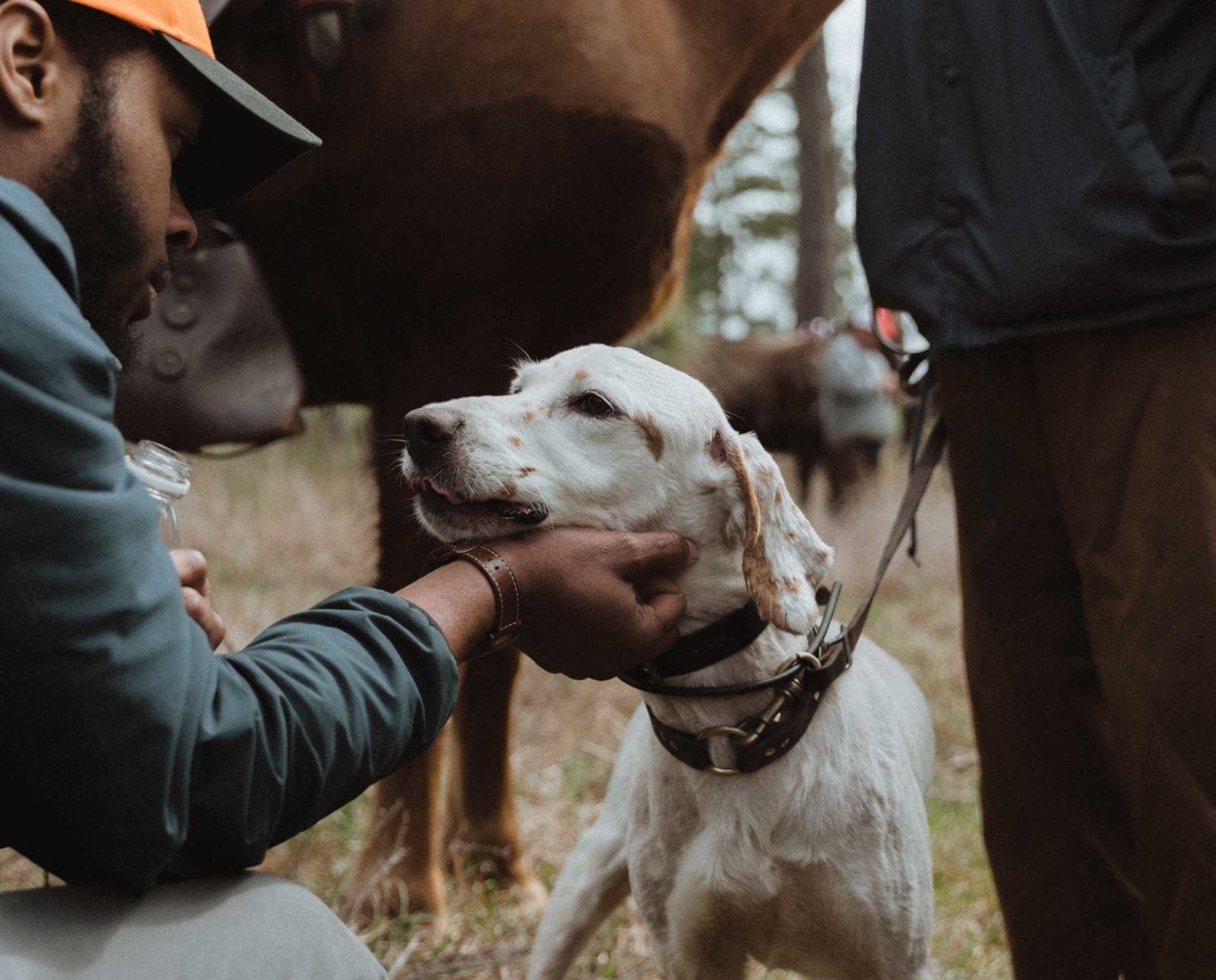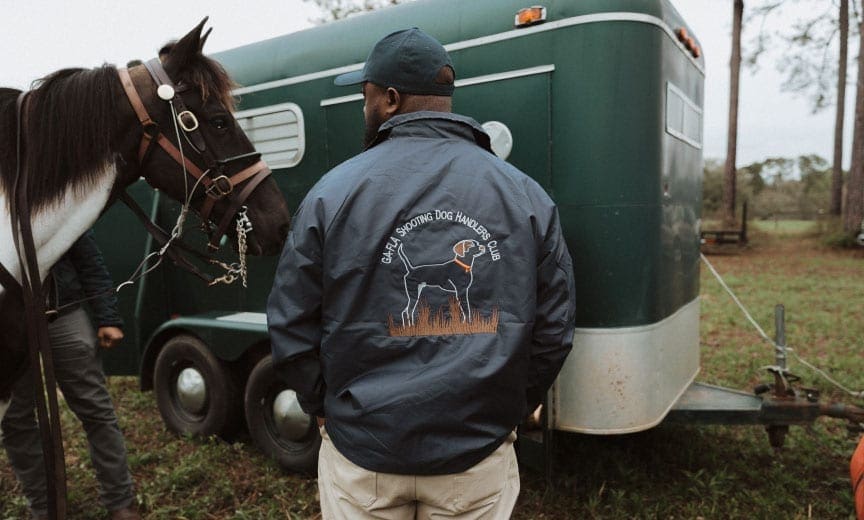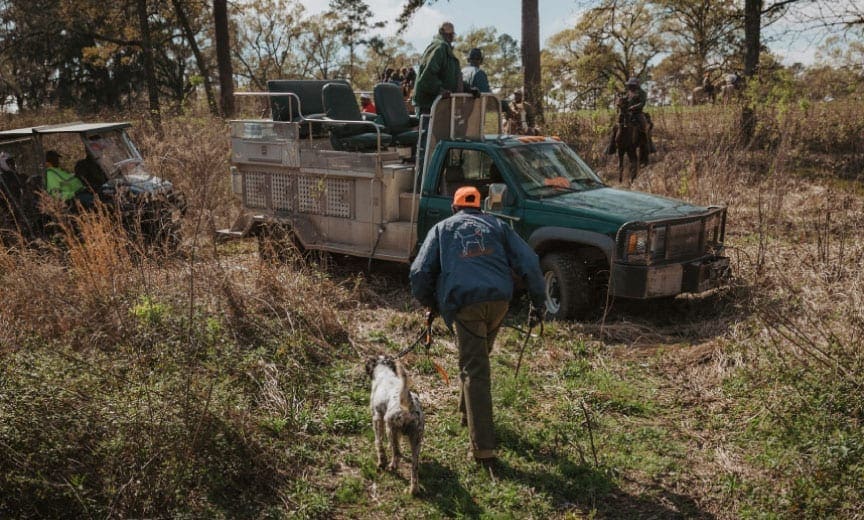Home » Field Trialing Dogs » Georgia-Florida Shooting Dog Handlers Club – Ambition to Tradition
Georgia-Florida Shooting Dog Handlers Club – Ambition to Tradition

Durrell Smith is a Georgia native, visual artist, wing shooter,…
The Field Trials of The Georgia-Florida Shooting Dog Handlers Club
Thinking about European traditions, I imagine a vast landscape of valleys and subtle pastures that have held thousands of years of traditions and rich, cultured European heritage. I think of royalty and grandeur and the castles that have been home to many kings, queens, dukes, ladies . . . and hunting dogs. I grew up in the world of art. I have spent the majority of my academic and professional life analyzing and digesting large works and various paintings that adorn museum walls from the Museum of Fine Arts, Boston to the halls of the High Museum here in Atlanta, down to the galleries of the Albany Museum in Albany, Georgia. In this world of art, I have experienced the fantasy that is quite synonymous with European royalty and heritage. Although America, being the young country that it is, is short on castles, we have our own version of these landmark residences. In the South, most would identify plantations as American castles, and their dogs point and stand no differently than those in Jean-Baptiste Oudry’s A Gundog Pointing a Partridge and Francois Desportes’ Dog and Gamebirds. What we have here in the South is the image and ideal of polish and class, and the regality of upland hunting that only exists among the most privileged and wealthy; a Class A type of bird hunter.
Imagine this, written in the 1994 article “Bobwhite in the Brush”:
There are 10 of us out in the field, friends and business associates of Loudermilk. We’re kicking around on horseback on his 4,600-acre Woodhaven plantation near Coolidge, Georgia, about an hour’s drive north of the Florida panhandle and an hour’s flight southwest of Atlanta. Loudermilk bought most of the land in 1983 and has added several contiguous tracts over the years. The compound, which encompasses guest cottages, riding stables, a trap range with clay pigeons, and lakes stocked with largemouth bass, is available for private use only.
This image likely exists among many folks who have never hunted in the Red Hills for bobwhite quail. It seems as though wild quail are almost unknown or unavailable to those who cannot afford the thousands of dollars it costs to finance even a half day’s hunt among these prestigious Southeastern hallmarks. To be totally transparent, up till this point there had been a missing element in that picture—one that bleeds into the shadows of southern plantation culture and bird dog history as it has been illustrated for the last century and more. The missing element is the foundation laid down by black bird dog handlers who stood humbly in the shadows of many of the greatest white dog men and field trial dogs on the American field circuit. From Man Rand and Peck Kelly to Leroy Clayton, Albert Cannon Sr., and Malichi Kalip, a number of great dog men have done everything from managing plantations, to breaking horses to pointers and pointers to bobwhites, to scouting for some of America’s renowned talents at every level of field trial history. I once found myself looking through old photos of field trialers, their dogs, and their horses, and every so often I would catch glimpses of black men hidden in the shadows of an already black and white photograph. I wondered who these men were, but seldom if ever was a description left about these figures in the background.
Watch the film: Hard Day Riding – A Southern Field Trial Film
When I first started hunting over dogs, I began to search through many magazines that showcased southern quail hunting, and I began to become disheartened at the idea that I would have to travel well outside of my home state to take a single wild bird and experience a covey flush. I didn’t have a Tennessee Walking Horse or a pointer or setter raised running in front of such a horse. I didn’t have thousands of dollars to pay to play, and at the time, I didn’t even have a fine double-barreled shotgun of best craftsmanship. Shortly thereafter, I made a time about rummaging in one of my favorite magazines, Garden & Gun, and landed on a piece that highlighted Neal Carter Jr. and Curtis Brooks Sr., president and vice president, respectively, of the Georgia-Florida Shooting Dog Handlers Club. Down this way, you don’t often see black folks with a beautiful pointer stacked up on the back of a tailgate, and for sure don’t see a group of black folks running a trial that’s lasted since 1981. I got my wits about me and found my way through the phoneline to contact Neal Carter, and the club has welcomed me and any other aspiring dog man with open arms—just as long as you understand that benefits of having two ears and one mouth and a load of dedication to the decades-old artform. What the organization down in Thomasville—commonly called the Black Dog Handlers Association, or simply the Black Handlers Club— has perfected has yet to be written, but just like everything else in African American history, its practices have been passed down through oral tradition and mentorship. And you’ve got to do your time before you can put a dog on the ground. That’s just how it is . . . and for good reason.

In the echoes of laughter and jest, you can find the history of a club that has endured since the 1980s, when men with way more resources offered way less to African American dog men. While scouting, the outspoken Malichi Kalip told Neal Carter, “Boy, you know we can do this ourself . . . they’ll let us run some dogs.” After consultations, it was requested that every handler provide a letter from the owners of the dogs in order to participate in a black field trial. In those times, black handlers were few and far between, as most were only allowed to be scouts. They were young and ambitious, but with much doubt looming in the horizon. By 1981, the word was out, and black handlers congregated on horseback for a field trial that would stand the test of time and grown over the past 40 years.
Now, a number of young men are eager for a shot at a placement and learning under the tutelage of Neal and Curtis. Neal will tell you, “I created a monster . . . and what I like about these young men, at the end of the day, they gon’ listen to me.” Truthfully, that’s what it’s all about, listening and learning from those men who have done it best. Every member of the club stands on brotherhood, and everyone is willing to help each other learn the ways of bird dogs. That is, up until dogs get put on the ground on the first Monday of March. Then it’s all love, hard work, and healthy competition from sunup till sundown that day with each participant hoping to display the finest broke dog work on this side of the Flint River.
These days, I’m hunting with my own fine double gun, my favorite 20-gauge Beretta 686 Silver Pigeon in the early season. As McCarthy says, “a yellow lab . . . called into action to retrieve downed game because of her ‘soft mouth.’” Well, I have a yellow Labrador, too, and a young pointer of the finest Elhew bloodlines from Pinehill Kennels. I hope I did it right and stayed true to our tradition. Put it plain, pointers point staunch, tall, and tight, and retrievers retrieve swiftly and manneredly. Job can’t be done no other kind of way, far as I’ve learned it. On a personal note, after January, it’s mostly about my .22 blank pistol on my hip and flushing whip to move birds and tune up a broke dog. Feels like March is right around the corner.

Historically in the Black Handlers Club trial, pointers are the dogs of choice, with setters making their introduction in recent years. Curtis Brooks Sr. took a first place win during the 2019 trial with his setter, Tamathlion Cody. The 2020 trial saw the likes of Joe Fryson round up his sixth club win with Melrose Big Ramblin. But the experience deeper than just a trophy and trash talk. You’ll often hear Neal say you have got to learn your dog, in and out, up and down. You’d be best suited to learn the land and the habits of the birds themselves as the birds are wild plantation quail. Every handler is braced for 30 minutes, and riding an all-day hunt with a lunch break is on the agenda. The thorns and briars are miserable, and a compound curse word or two is common. Just be sure that dog is on point long before you shoot and doesn’t creep an inch; it’s got to be done with style and finesse. Everyone expects judgments to be fair and unbiased, as the judges are respected members of the local plantation community.
Put it all together—the men and their dogs, the guns and the birds, the friendly competition and the messing around—and the event is something worthy of a painted picture. You will see to it that the black dog men of the Georgia-Florida Shooting Dog Handlers club settle for nothing less that the dogs’ best performance. They’ve upheld the same standard for the past 40 years.
*This article appears in the Summer 2020 Issue of Project Upland Magazine
Jean-Baptiste Oudry, “A Gundogs Pointing a Partridge”, France, 1725
Francois Desportes, “Dog and Gamebirds”, France, 1711
McCarthy, Joseph L. “Bobwhite in the Brush.” Business Premium Collection, no. 96, 1994, 70–72., www.thefreelibrary.com/Bobwhite in the brush.-a015611639.
Durrell Smith is a Georgia native, visual artist, wing shooter, and dog handler. While creating compelling ink and watercolor illustrations based on his field experiences and hunting dogs, he also runs The Sporting Life Notebook and the Minority Outdoor Alliance. As a first generation hunter, Durrell seeks to learn and contribute to the community by connecting with visionaries and veterans within the bird dog community who are willing to share stories and knowledge about the various breeds, creating a bridge to welcome new and novice dog handlers to the gun dog community.



